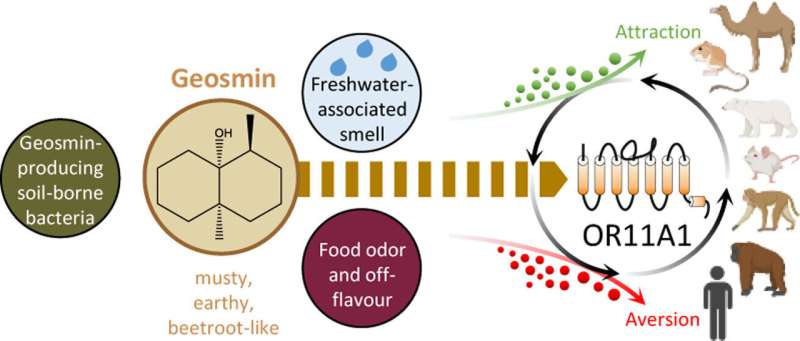This article has been reviewed according to Science X's editorial process and policies. Editors have highlighted the following attributes while ensuring the content's credibility:
fact-checked
peer-reviewed publication
trusted source
proofread
A nose for earthy notes: Human odorant receptor for geosmin identified for the first time

Geosmin is a volatile compound of microbial origin with a distinct "earthy" to "musty" odor that can affect the quality of water and food. It is responsible for the typical odor that occurs when rain falls on dry soil. This odorant is produced by microorganisms in the soil and is also found in plants such as cactus flowers and red beet.
Many creatures react very sensitively to geosmin, whereby the odorant can have a repellent or attractive effect. For example, it warns fruit flies of spoiled food. Camels, on the other hand, are attracted to water-rich areas. "This shows that geosmin acts as a chemical signaling substance in the animal kingdom and certainly also in humans," explains first author Lena Ball from the Leibniz Institute.
Geosmin can impair food quality
"While the smell of geosmin suits red beet, its presence in foods such as fish, beans, cocoa, water, wine or grape juice is problematic. In these, it greatly impairs sensory quality and acceptance," explains Stephanie Frank, food chemist at the Leibniz Institute. Even low concentrations of 4 to 10 ng/L are sufficient for a person to perceive the odor in water. This corresponds to about one teaspoon of geosmin in the water volume of 200 Olympic swimming pools.
Although geosmin has been known since 1965 and is important for food production, it was previously unknown which odorant receptor humans use to perceive geosmin. The team headed by principal investigator Dietmar Krautwurst has now carried out bidirectional receptor screening and identified and functionally characterized the corresponding receptor for the first time.
The study is published in the Journal of Agricultural and Food Chemistry.
Only one human odorant receptor for geosmin
Of 616 human olfactory receptor variants tested, only the OR11A1 receptor responded to physiologically relevant concentrations of the odorant. The team also investigated whether the identified receptor reacts to other food-relevant odorants. Of the 177 substances tested, only the earthy-smelling 2-ethylfenchol was able to significantly activate the receptor. This compound is also of microbial origin.
"As geosmin is an important signaling substance in the animal kingdom, we also investigated how the odorant receptors of the kangaroo rat, mouse, rhesus monkey, Sumatran orangutan, polar bear and camel, which are genetically most closely related to the human receptor, react to geosmin.
"We wanted to find out whether the highly selective recognition of geosmin by the same receptor has been preserved over 100 million years of mammalian evolution," reports doctoral student Lena Ball.
As the team's comparative studies show, the human receptor, together with the monkey receptors, is one of the less sensitive sensors. In the experiment, the kangaroo rat's odorant receptor reacted around 100 times more sensitively to geosmin than the human receptor.
"The new findings on the highly sensitive odorant receptors of some animals once again emphasize the biological relevance of geosmin as a signaling substance. They could also help to develop novel detection systems that can be used to monitor food quality during production and storage or to control the water quality of freshwater reservoirs," concludes Dietmar Krautwurst.
More information: Lena Ball et al, Geosmin, a Food- and Water-Deteriorating Sesquiterpenoid and Ambivalent Semiochemical, Activates Evolutionary Conserved Receptor OR11A1, Journal of Agricultural and Food Chemistry (2024). DOI: 10.1021/acs.jafc.4c01515
Journal information: Journal of Agricultural and Food Chemistry
Provided by Leibniz Institute for Food Systems Biology





















